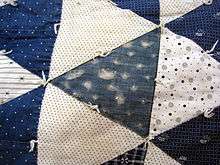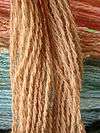Mordant
A mordant or dye fixative is a substance used to set dyes on fabrics or tissue sections by forming a coordination complex with the dye which then attaches to the fabric or tissue.[1] It may be used for dyeing fabrics, or for intensifying stains in cell or tissue preparations. The term mordant comes from the present participle of French mordre, "to bite". In the past, it was thought that a mordant helped the dye bite onto the fiber so that it would hold fast during washing. A mordant is often a polyvalent metal ion.[2] The resulting coordination complex of dye and ion is colloidal and can be either acidic or alkaline.
Common dye mordants
Mordants include tannic acid, alum, urine, chrome alum, sodium chloride, and certain salts of aluminium, chromium, copper, iron, iodine, potassium, sodium, tungsten and tin.
Iodine is often referred to as a mordant in Gram stains, but is in fact a trapping agent.[3]
Mordants in history
- The mordant alum became a cause of friction between the Vatican and Henry VII of England, when Henry financed a shipping and trading system with the Ottoman Empire that provided cheaper alum to Europe's Wool Industry, breaking the Pope's monopoly on the trade.[4]
Dyeing methods

The three methods used for mordanting are:
- Pre-mordanting (onchrome): The substrate is treated with the mordant and then dyed.
- Meta-mordanting (metachrome): The mordant is added in the dye bath itself.
- Post-mordanting (afterchrome): The dyed material is treated with a mordant.
The type of mordant used changes the shade obtained after dyeing and also affects the fastness property of the dye. The application of mordant, either pre-mordant, meta-mordant or post-mordant methods, is influenced by:
- The action of the mordant on the substrate: if the mordant and dye methods are harsh (for example, an acidic mordant with an acidic dye), pre-mordanting or post-mordanting limits the potential for damage to the substrate.
- The stability of the mordant or dye lake or both: the formation of a stable dye lake means that the mordant can be added in the dye without risk of losing the dye properties (meta-mordanting).
Dye results can also rely on the mordant chosen as the introduction of the mordant into the dye will have a marked effect on the final color. Each dye can have different reactions to each mordant. For example, cochineal scarlet, or Dutch scarlet as it came to be known, used cochineal along with a tin mordant to create a brilliant orange-hued red.[5] Residual iron mordant can damage or fade fabric, producing "dye rot".[6]
The dye lake
The dye lake is an insoluble molecule formed when the complex of dye and mordant are combined, which then attaches to the substrate. Mordants increase the fastness of the dye since the larger molecule is now bonded to the fibre.[2]
The term "lake" is derived from the term lac, the secretions of the Indian wood insect Laccifer lacca (formerly known as the Coccus lacca). This is the same insect from which shellac is obtained.[7] The type of mordant used can change the colour of both the dye-plus-mordant solution and influence the shade of the final product.
Wool
Unlike cotton, wool is highly receptive toward mordants. Due to its amphoteric nature wool can absorb acids and bases with equal efficiency. When wool is treated with a metallic salt it hydrolyses the salt into an acidic and basic component. The basic component is absorbed at –COOH group and the acidic component is removed during washing. Wool also has a tendency to absorb fine precipitates from solutions; these cling to the surface of fibres and dye particles attached to these contaminants result in poor rubbing fastness.
Silk
Like wool, silk is also amphoteric and can absorb both acids as well as bases. However, wool has thio groups (-SH) from the cystine amino acid, which act as reducing agent and can reduce hexavalent chromium of potassium dichromate to trivalent form. The trivalent chromium forms the complex with the fibre and dye. Therefore, potassium dichromate cannot be used effectively as mordant.
Animal and plant tissues
In Histology, mordants are indispensable in fixing dyes to tissues for microscopic examination.
Methods for mordant application depend on the desired stain and tissues under study; pre-, meta- and post-mordanting techniques are used as required.
The most commonly used stain used in diagnostic histology of animal tissues is Harris' haematoxylin as part of a haematoxylin and eosin (H&E) stain.
External links
References
- ↑ IUPAC, Compendium of Chemical Terminology, 2nd ed. (the "Gold Book") (1997). Online corrected version: (1993) "mordant".
- 1 2 Llewellyn, Bryan D. (May 2005). "Stain Theory – How mordants work". Archived from the original on August 14, 2007.
- ↑ Llewellyn, Bryan D. (May 2005). "Stain Theory – Trapping agents". Archived from the original on June 20, 2008.
- ↑ Henry VII of England, see section on Trade.
- ↑ Phipps, Elena (2010). Cochineal Red The Art History of a Color, p34. Yale University Press, New Haven and London. ISBN 978-0-300-15513-6.
- ↑
- ↑ Llewellyn, Bryan D. (May 2005). "Stain Theory – Lac". Archived from the original on August 13, 2007.
